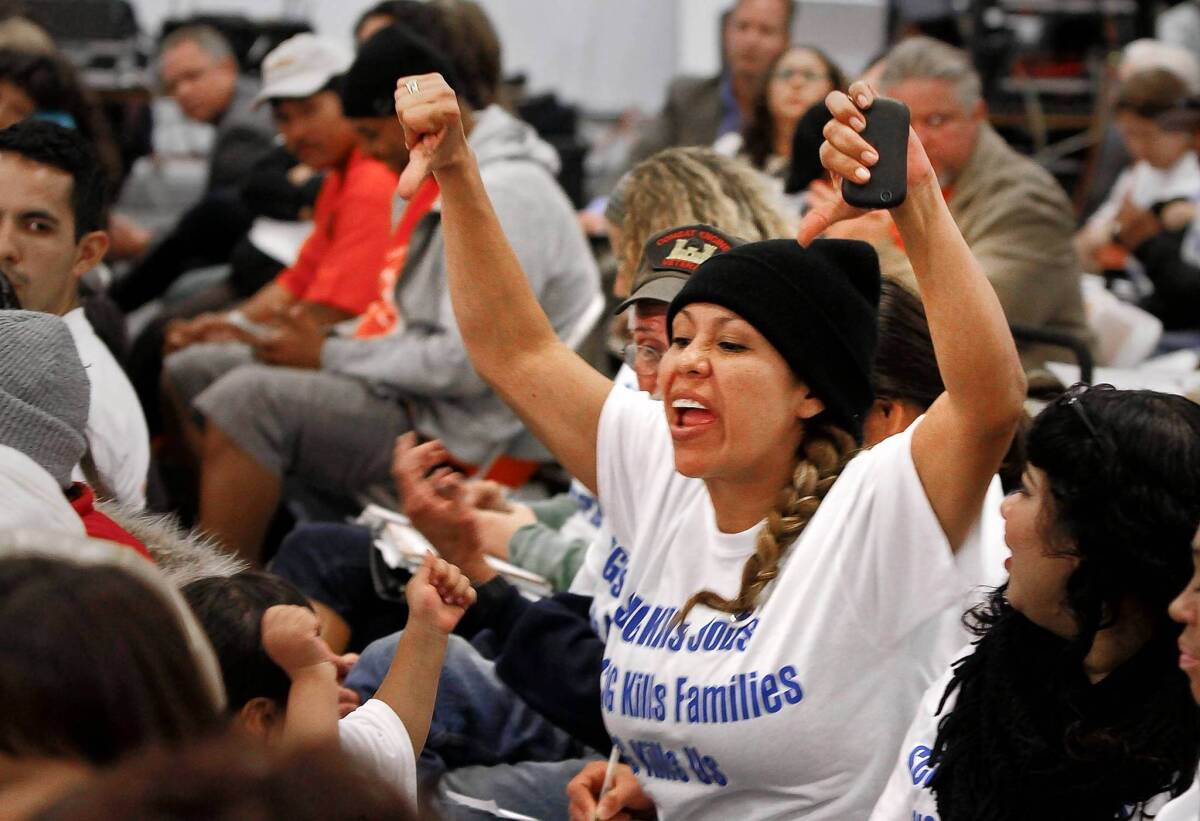L.A. harbor commissioners OK rail yard near port

Over the objections of environmentalists, community groups and neighboring Long Beach officials, Los Angeles harbor commissioners on Thursday approved a $500-million rail yard that could dramatically boost business but also drive more noise and dirty air into schools, parks and low-income neighborhoods.
The proposal to create a huge staging center for trains hauling freight from the Port of Los Angeles has raised questions about environmental justice, particularly for the adjacent poor and working-class neighborhoods of west Long Beach. There, residents already live in an area known as the “diesel death zone” because of port-related air pollution.
The clash also has pitted Los Angeles and Long Beach against each other, even though the cities have collaborated for years on initiatives to reduce harmful emissions in their harbors, which make up the largest combined port complex in the nation.
“You’ve done precious little to mitigate the impacts we see [with the rail yard],” Long Beach Mayor Bob Foster told the commission, asserting that it has typically provided more protection for Los Angeles residents who live near port projects. “Do you value the life of a kid on your side of the border more than a kid on my side of the border?”
Nevertheless, after more than six hours of public testimony, commissioners voted unanimously for the Southern California International Gateway — a 153-acre cargo facility to be built off the 710 Freeway by the Burlington Northern Santa Fe Railway Co. It would be capable of handling up to 2.8 million 20-foot shipping containers a year by 2035.
The board also certified the project’s final environmental impact report. Harbor Commissioner Robin Kramer was absent.
“We must look at the need to ensure that good jobs remain here and continue to grow,” said commission Vice President David Arian, who contended that the project would help the harbor deal with increased competition from other ports as more ships move through a widened Panama Canal. “There needs to be additional rail capacity. It is essential to our future.”
The site, which would be visited by up to 8,200 trucks a day, is in Wilmington next to California 103, between Sepulveda Boulevard and California 1 and east of Alameda Street. It is bordered by industrial uses except for the east side, where there are schools, playing fields, parks, housing for homeless veterans and residential neighborhoods.
Health studies indicate that the area has disproportionately high rates of asthma and respiratory illness related to emissions from port operations, especially among children.
Railroad and port officials say, however, that the facility would be one of the “greenest” freight yards in the nation and provide air quality improvements by eliminating more than a million truck trips a year from the Long Beach Freeway going to and from the ports. Those container-hauling trucks now must travel 20 miles up the busy freeway to Burlington Northern’s giant Hobart Yard.
Trucks serving the new facility would be clean diesels as mandated by the port’s air quality requirements. Electric cranes as well as low-emission locomotives and hostlers would be used in the yard.
Noise and light pollution would be reduced by shielded lights and a sound wall along the project’s border with west Long Beach. To keep trucks out of surrounding neighborhoods, haulers would be required to enter and leave the yard using dedicated lanes off the Terminal Island Freeway. Efforts also are planned to eventually use zero-emission vehicles and the cleanest locomotives.
The project is widely supported by labor unions, business organizations, elected officials and regional planning agencies. They cite the creation of hundreds of jobs, the benefits of eliminating truck trips on the 710 and the need to accommodate port growth.
Burlington Northern’s environmental analysis, however, still shows there would be significant unavoidable environmental impacts that would fall disproportionately on low-income communities.
Officials from environmental groups and the South Coast Air Quality Management District questioned the adequacy of the impact report and noted that the project would increase potentially harmful emissions, including nitrogen oxide, which would exceed federal limits.
David Pettit, an attorney for the Natural Resources Defense Council, which might challenge the project in court, reminded the commission that its former president, S. David Freeman, said eight years ago that no diesel trucks should be allowed to use the international gateway.
Armed with a recent harbor department report, Andrea Hricko, a professor of preventive medicine at USC, said the benefits of reducing truck traffic on the 710 could be temporary because of the increasing use of “transloading,” in which goods in 40-foot cargo containers are consolidated into 53-foot containers by freight companies before being taken to Hobart and other yards.
Residents of west Long Beach, some of them speaking in Spanish and others with asthma, pleaded with commissioners to either reject the project or provide adequate measures to reduce its effects. One community activist, Jesse Marquez, distributed copies of death certificates of harbor area residents who have died of respiratory illnesses.
Foster and Long Beach City Councilman James Johnson, whose district would be affected by the project, called for more remedial measures such as a buffer zone, zero-emission vehicles and funds to help pay for additional mitigation.
From discussions with Burlington Northern, Foster said, the attitude of the railroad — owned by a conglomerate led by billionaire investor Warren Buffett — is that it would rather wait to be sued before reducing some of the significant impacts.
“If Warren Buffett lived 20 feet from the Southern California International Gateway,” Foster said, “would the applicant [Burlington Northern] wait for him to sue before providing mitigation?”
More to Read
Sign up for Essential California
The most important California stories and recommendations in your inbox every morning.
You may occasionally receive promotional content from the Los Angeles Times.










